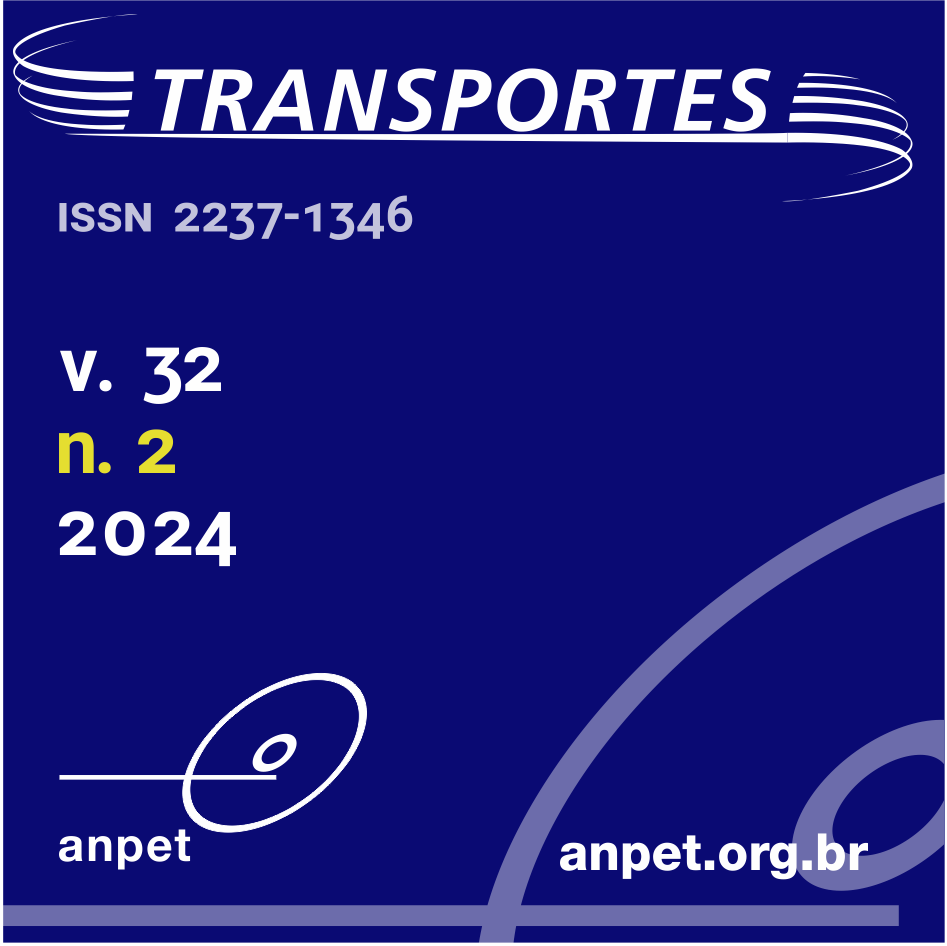Sylvaroad rejuvenating agent’s dosage based on rheological properties of aged asphalt Binder
DOI:
https://doi.org/10.58922/transportes.v32i2.2920Keywords:
Performance grade, Rejuvenating agent, Asphalt binder, Reclaimed asphalt pavementAbstract
The technique of using rejuvenating agents (RA) to recover aged binders’ properties has still a lot to develop since the RA amount directly affects binders’ performance on rutting and fatigue, main factors of pavement degradation. This research evaluated dosage methods of RA Sylvaroad RP1000 in a service-aged binder, based on rheological parameters. The binder was extracted from Reclaimed Asphalt Pavement (RAP) using centrifugation and rotoevaporation. Samples with 0, 3, 5, 7, and 10% RA were produced and subjected to Rolling Thin Film Oven Test (RTFOT) and rheological tests on the Dynamic Shear Rheometer (DSR). The optimum dosage was assessed, based on virgin binder High-temperature Performance Grade (PGH). Susceptibility parameters to fatigue and rutting were also measured by Multiple Stress Creep and Recovery (MSCR) and Linear Amplitude Sweep (LAS) tests, respectively. Results showed that the RA was effective, and the dose able to recover virgin binder’s PGH was 10.6% of the aged binder mass. Non-recoverable compliance, stress recovery rate and fatigue damage tolerance results showed this content would lead to satisfactory and superior results to those of the virgin binder (50/70 penetration grade). However, a lower content would already be able to recover aged binder’s properties and improve its performance.
Downloads
References
ASTM (2006) ASTM D 4402: Standard Test Method for Viscosity Determination of Asphalt at Elevated Temperatures Using a Rotational Viscometer. Philadelphia, USA: ASTM.
ASTM (2015) ASTM D 7175: Standard Test Method for Determining the Rheological Properties of Asphalt Binder Using a Dynamic Shear Rheometer. Philadelphia, USA: ASTM.
ASTM (2016a) ASTM D 36: Standard Test Method for Softening Point of Bitumen (Ring-and-Ball Apparatus). Philadelphia, USA, ASTM.
ASTM (2016b) ASTM D 6373: Standard Specification for Performance Graded Asphalt Binder. Philadelphia, USA: ASTM.
ASTM (2016c) ASTM D 7643: Standard Practice for Determining the Continuous Grading Temperatures and Continuous Grades for PG Graded Asphalt Binders. Philadelphia, USA: ASTM.
ASTM (2017) ASTM D 113: Standard Test Method for Ductility of Asphalt Materials. Philadelphia, USA: ASTM.
ASTM (2018a) ASTM D 92: Standard Test Method for Flash and Fire Points by Cleveland Open Cup Tester. Philadelphia, USA: ASTM.
ASTM (2018b) ASTM D 70: Standard Test Method for Density of Semi-Solid Asphalt Binder (Pycnometer Method). Philadelphia, USA: ASTM.
ASTM (2019) ASTM D 2872: Standard Test Method for Effect of Heat and Air on a Moving Film of Asphalt (Rolling Thin-Film Oven Test). Philadelphia, USA: ASTM.
ASTM (2020a) ASTM D 7405: Multiple Stress Creep and Recovery (MSCR) of Asphalt Binder Using a Dynamic Shear Rheometer. Philadelphia, USA: ASTM.
ASTM (2020b) ASTM D5: Standard Test Method for Penetration of Bituminous Materials. Philadelphia, USA: ASTM.
AASHTO (2018) AASHTO M 332: Standard Specification for Performance-Graded Asphalt Binder Using Multiple Stress Creep Recovery (MSCR) Test. Philadelphia, USA: ASTM.
AASHTO (2020) AASHTO T 391: Standard Method of Test for Estimating Fatigue Resistance of Asphalt Binders Using the Linear Amplitude Sweep. Washington, D.C, USA: AASHTO.
Arámbula-Mercado, E.; F. Kaseer; A.E. Martin et al. (2018) Evaluation of recycling agent dosage selection and incorporation methods for asphalt mixtures with high RAP and RAS contents, Construction & Building Materials, v. 158, p. 432-42. DOI: 10.1016/j. conbuildmat.2017.10.024. DOI: https://doi.org/10.1016/j.conbuildmat.2017.10.024
Asadi, B.; N. Tabatabaee and R. Hajj (2021) Use of linear amplitude sweep test as a damage tolerance or fracture test to determine the optimum content of asphalt rejuvenator, Construction & Building Materials, v. 300, p. 123983. DOI: 10.1016/j. conbuildmat.2021.123983. DOI: https://doi.org/10.1016/j.conbuildmat.2021.123983
Bajaj, A.; A.E. Martin; G. King et al. (2020) Evaluation and classification of recycling agents for asphalt binders, Construction & Building Materials, v. 260, p. 119864. DOI: 10.1016/j.conbuildmat.2020.119864. DOI: https://doi.org/10.1016/j.conbuildmat.2020.119864
Cao, X.; H. Wang; X. Cao et al. (2018) Investigation of rheological and chemical properties of asphalt binder rejuvenated with waste vegetable oil, Construction & Building Materials, v. 180, p. 455-63. DOI: 10.1016/j.conbuildmat.2018.06.001. DOI: https://doi.org/10.1016/j.conbuildmat.2018.06.001
Chen, H.; Y. Zhang and H.U. Bahia (2021) Estimating asphalt binder fatigue at multiple temperatures using a simplified pseudo-strain energy analysis approach in the LAS test, Construction & Building Materials, v. 266, p. 120911. DOI: 10.1016/j. conbuildmat.2020.120911. DOI: https://doi.org/10.1016/j.conbuildmat.2020.120911
Deng, M.; X. Cao; Z. Li et al. (2022) Investigating properties and intermolecular interactions of sludge bio-oil modified asphalt, Journal of Molecular Liquids, v. 360, p. 119415. DOI: 10.1016/j.molliq.2022.119415. DOI: https://doi.org/10.1016/j.molliq.2022.119415
Espinoza-Luque, A.F.; I.L. Al-Qadi and H. Ozer (2018) Optimizing rejuvenator content in asphalt concrete to enhance its durability, Construction & Building Materials, v. 179, p. 642-8. DOI: 10.1016/j.conbuildmat.2018.05.256. DOI: https://doi.org/10.1016/j.conbuildmat.2018.05.256
Fang, Y.; Z. Zhang; J. Yang et al. (2021) Comprehensive review on the application of bio-rejuvenator in the regeneration of waste asphalt materials, Construction & Building Materials, v. 295, p. 123631. DOI: 10.1016/j.conbuildmat.2021.123631. DOI: https://doi.org/10.1016/j.conbuildmat.2021.123631
Gadler, F. (2018) Desempenho e Propriedades Mecânicas de Misturas Asfálticas Mornas Produzidas com Revestimento Asfáltico Fresado e Agregado de Resíduo de Concreto em Substituição da Fração Graúda e Miúda da Granulometria. Theses (Master’s Degree in Civil Engineering). Universidade Federal do Paraná, Curitiba. Available at: <https://hdl.handle.net/1884/69718> (accessed 05/15/2023).
Hospodka, M.; B. Hofko and R. Blab (2018) Impact of distillation temperature on the solvent residue and viscoelastic properties of asphalt binders, Road Materials and Pavement Design, v. 19, n. 6, p. 1275-87. DOI: 10.1080/14680629.2017.1304234. DOI: https://doi.org/10.1080/14680629.2017.1304234
Huang, Y.H. (2004) Pavement Analysis and Design (2nd ed.). Upper Saddle River, USA: Pearson Prentice Hall.
Im, S.; P. Karki and F. Zhou (2016) Development of new mix design method for asphalt mixtures containing RAP and rejuvenators, Construction & Building Materials, v. 115, p. 727-34. DOI: 10.1016/j.conbuildmat.2016.04.081. DOI: https://doi.org/10.1016/j.conbuildmat.2016.04.081
Kaseer, F.; E. Arambula-Mercado; L.G. Cucalon et al. (2018a) Performance of asphalt mixtures with high recycled materials content and recycling agent, The International Journal of Pavement Engineering, v. 21, n. 7, p. 863-77. DOI: 10.1080/10298436.2018.1511990. DOI: https://doi.org/10.1080/10298436.2018.1511990
Kaseer, F.; L.G. Cucalon; E. Arámbula-Mercado et al. (2018b) Practical tools for optimizing recycled materials content and recycling agent dosage for improved short- and long-term performance of rejuvenated binder blends and mixtures, Asphalt Paving Technology, v. 87, n. aapt, p. 513-50. DOI: 10.12783/aapt2018/33816. DOI: https://doi.org/10.12783/aapt2018/33816
Kraton Corporation (2017) Safety Data Sheet and Product Data Sheet, Sylvaroad™ RP 1000 Performance Additive. Available at: <https://www.kratonpolymers.cn/literature/SYLVAROAD-RP1000-Performance-Additive-brochure.pdf> (accessed 05/15/2023).
Mikhailenko, P.; P. Ateian and H. Baaj (2020) Extraction and recovery of asphalt binder: a literature review, International Journal of Pavement Research and Technology, v. 13, n. 1, p. 20-31. DOI: 10.1007/s42947-019-0081-5. DOI: https://doi.org/10.1007/s42947-019-0081-5
Mikhailenko, P.; G. Webber and H. Baaj (2021) Evaluation of solvents for asphalt extraction, Road Materials and Pavement Design, v. 22, n. 5, p. 1195-206. DOI: 10.1080/14680629.2019.1661277. DOI: https://doi.org/10.1080/14680629.2019.1661277
Nikolaides, A. (2015) Highway Engineering Pavements: Materials and Control of Quality. Boca Raton, USA: CRC Press.
Noferini, L.; A. Simone; C. Sangiorgi et al. (2017) Investigation on performances of asphalt mixtures made with reclaimed asphalt pavement: effects of interaction between virgin and RAP bitumen, International Journal of Pavement Research and Technology, v. 10, n. 4, p. 322-32. DOI: 10.1016/j.ijprt.2017.03.011. DOI: https://doi.org/10.1016/j.ijprt.2017.03.011
Porot, L. and D. Bell (2019) Bringing recycling to the next level using bio-based rejuvenator. In 18th Australian Asphalt Pavement Association Conference 2019. Sidney, Australia: AFPA, p. 1-13.
Smith, K. (2015) A Rejuvenator Derived from Pine Trees and Natural Asphalt. Available at: <https://www.worldhighways.com/ wh6/feature/rejuvenator-derived-pine-trees-and-natural-asphalt> (accessed 12/05/2023).
Speight, J.G. (2016) Asphalt Materials Science and Technology. Oxford, UK: Elsevier Inc. DOI: https://doi.org/10.1016/B978-0-12-800273-5.00010-6
Wang, J.; S. Lv; J. Liu et al. (2023) Performance evaluation of aged asphalt rejuvenated with various bio-oils based on rheological property index, Journal of Cleaner Production, v. 385, p. 135593. DOI: 10.1016/j.jclepro.2022.135593. DOI: https://doi.org/10.1016/j.jclepro.2022.135593
West, R.C. and A. Copeland (2015). High RAP Asphalt Pavements: Japan Practice - Lessons Learned. Maryland: NAPA. Available at: <https://www.asphaltpavement.org/uploads/documents/EngineeringPubs/IS139_High_RAP_Asphalt_Pavements_Japan_ Practice-lr.pdf> (accessed 12/05/2023).
Yaro, N.S.A.; M.H. Sutanto; N.Z. Habib et al. (2023) Modeling and optimization of rheological properties and aging resistance of asphalt binder incorporating palm oil mill waste using response surface methodology, Journal of Infrastructure Intelligence and Resilience, v. 2, n. 1, p. 100026. DOI: 10.1016/j.iintel.2023.100026. DOI: https://doi.org/10.1016/j.iintel.2023.100026
Zaumanis, M.; R.B. Mallick and R. Frank (2014) Determining optimum rejuvenator dose for asphalt recycling based on Superpave performance grade specifications, Construction & Building Materials, v. 69, p. 159-66. DOI: 10.1016/j.conbuildmat.2014.07.035. DOI: https://doi.org/10.1016/j.conbuildmat.2014.07.035
Zaumanis, M.; R.B. Mallick; L. Poulikakos et al. (2014) Influence of six rejuvenators on the performance properties of Reclaimed Asphalt Pavement (RAP) binder and 100% recycled asphalt mixtures, Construction & Building Materials, v. 71, p. 538-50. DOI: 10.1016/j.conbuildmat.2014.08.073. DOI: https://doi.org/10.1016/j.conbuildmat.2014.08.073
Downloads
Published
How to Cite
Issue
Section
License
Copyright (c) 2024 Felipe Tiago Joenck, Vanessa Bacca Couto Joenck, Joe Arnaldo Villena Del Carpio, João Victor Staub de Melo

This work is licensed under a Creative Commons Attribution 4.0 International License.
Authors who submit papers for publication by TRANSPORTES agree to the following terms:
- The authors retain the copyright and grant Transportes the right of first publication of the manuscript, without any financial charge, and waive any other remuneration for its publication by ANPET.
- Upon publication by Transportes, the manuscript is automatically licensed under the Creative Commons License CC BY 4.0 license. This license permits the work to be shared with proper attribution to the authors and its original publication in this journal, and to be adapted for non-commercial purposes, provided appropriate credit is given and any derivative works are distributed under the same terms.
- Authors are authorized to enter into additional separate contracts for the non-exclusive distribution of the version of the manuscript published in this journal (e.g., publishing in an institutional repository or as a book chapter), with recognition of the initial publication in this journal, provided that such a contract does not imply an endorsement of the content of the manuscript or the new medium by ANPET.
- Authors are permitted and encouraged to publish and distribute their work online (e.g., in institutional repositories or on their personal websites) after the editorial process is complete. As Transportes provides open access to all published issues, authors are encouraged to use links to the DOI of their article in these cases.
- Authors guarantee that they have obtained the necessary authorization from their employers for the transfer of rights under this agreement, if these employers hold any copyright over the manuscript. Additionally, authors assume all responsibility for any copyright infringements by these employers, releasing ANPET and Transportes from any responsibility in this regard.
- Authors assume full responsibility for the content of the manuscript, including the necessary and appropriate authorizations for the disclosure of collected data and obtained results, releasing ANPET and Transportes from any responsibility in this regard.









